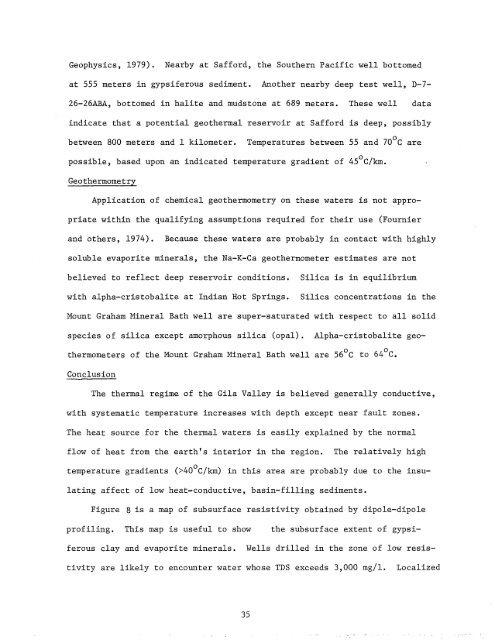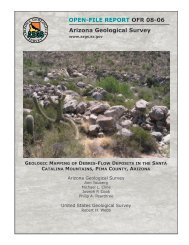geothermal resource potential of the safford-san simon basin, arizona
geothermal resource potential of the safford-san simon basin, arizona
geothermal resource potential of the safford-san simon basin, arizona
Create successful ePaper yourself
Turn your PDF publications into a flip-book with our unique Google optimized e-Paper software.
Geophysics, 1979).<br />
Nearby at Safford, <strong>the</strong> Sou<strong>the</strong>rn Pacific well bottomed<br />
at 555 meters in gypsiferous sediment.<br />
Ano<strong>the</strong>r nearby deep test well, D-7-<br />
26-26ABA, bottomed in halite and mudstone at 689 meters. These well data<br />
indicate that a <strong>potential</strong> <strong>geo<strong>the</strong>rmal</strong> reservoir at Safford is deep, possibly<br />
between 800 meters and 1 kilometer.<br />
Temperatures between 55 and 70 0 C are<br />
o<br />
possible, based upon an indicated temperature gradient <strong>of</strong> 45 C/km.<br />
Geo<strong>the</strong>rmometry<br />
Application <strong>of</strong> chemical geo<strong>the</strong>rmometry on <strong>the</strong>se waters is not appropriate<br />
within <strong>the</strong> qualifying assumptions required for <strong>the</strong>ir use (Fournier<br />
and o<strong>the</strong>rs, 1974).<br />
Because <strong>the</strong>se waters are probably in contact with highly<br />
soluble evaporite minerals, <strong>the</strong> Na-K-Ca geo<strong>the</strong>rmometer estimates are not<br />
believed to reflect deep reservoir conditions.<br />
with a1pha-cristobalite at Indian Hot Springs.<br />
Silica is in equilibrium<br />
Silica concentrations in <strong>the</strong><br />
Mount Graham Mineral Bath well are super-saturated with respect to all solid<br />
species <strong>of</strong> silica except amorphous silica (opal).<br />
Alpha-cristobalite geo<strong>the</strong>rmometers<br />
<strong>of</strong> <strong>the</strong> Mount Graham Mineral Bath well are 56°C to 64°C.<br />
Conclusion<br />
The <strong>the</strong>rmal regime <strong>of</strong> <strong>the</strong> Gila Valley is believed generally conductive,<br />
with systematic temperature increases with depth except near fault zones.<br />
The heat source for <strong>the</strong> <strong>the</strong>rmal waters is easily explained by <strong>the</strong> normal<br />
flow <strong>of</strong> heat from <strong>the</strong> earth's interior in <strong>the</strong> region.<br />
The relatively high<br />
temperature gradients (>40 o C/km)<br />
in this area are probably due to <strong>the</strong> insulating<br />
affect <strong>of</strong> low heat-conductive, <strong>basin</strong>-filling sediments.<br />
Figure 8 is a map <strong>of</strong> subsurface resistivity obtained by dipole-dipole<br />
pr<strong>of</strong>iling. This map is useful to show <strong>the</strong> subsurface extent <strong>of</strong> gypsiferous<br />
clay and evaporite minerals.<br />
Wells drilled in <strong>the</strong> zone <strong>of</strong> low resistivity<br />
are likely to encounter water whose TDS exceeds 3,000 mg/l.<br />
Localized<br />
35

















